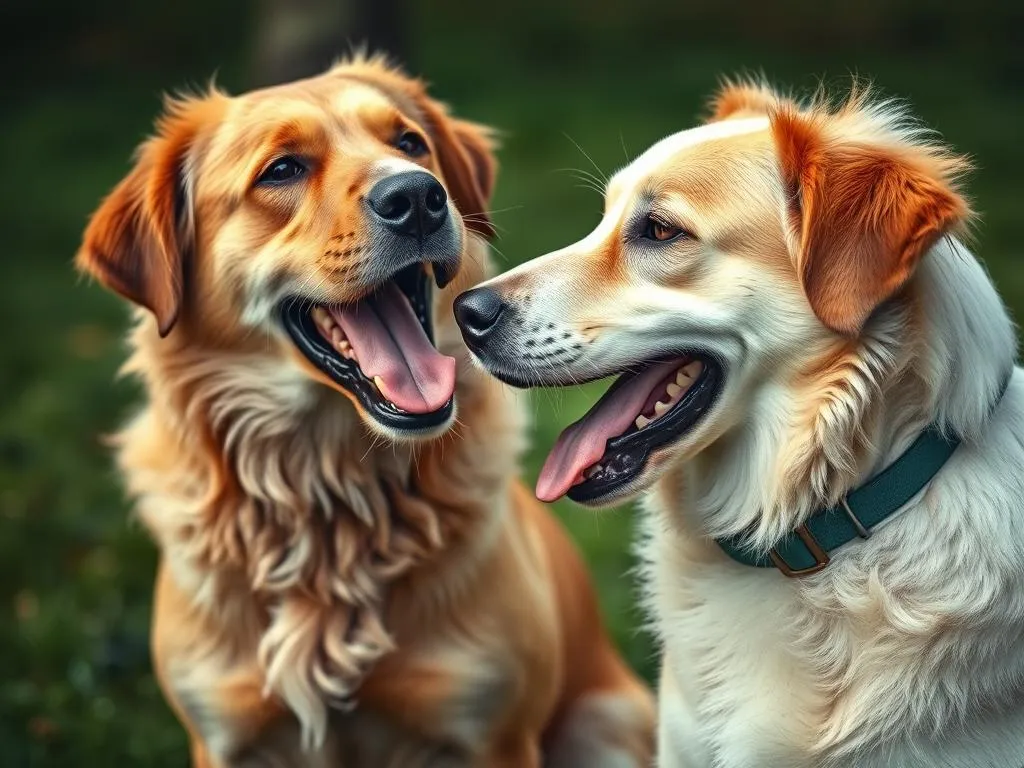
Introduction
Understanding dog behavior is crucial for any dog owner or enthusiast. How do dogs communicate with each other? This question is at the heart of interpreting our canine companions’ actions and intentions. Dogs, by their very nature, are social animals. They thrive on interaction, and effective communication is vital for their social structures and relationships.
In this article, we will delve into the various ways dogs convey messages to one another. We will explore vocalizations, body language, and scent signals, as well as factors that influence these communications. By the end of this piece, you will have a deeper understanding of your dog’s behavior and how to foster better communication between your furry friend and yourself.
Understanding Dog Communication
The Basics of Canine Communication
Dogs communicate through a variety of methods, each serving its unique purpose. The three primary types of communication are:
-
Vocal Communication: This includes barking, growling, whining, and howling. Each sound conveys specific messages and emotions.
-
Visual Communication: Dogs use body language to express themselves. For example, the position of a dog’s ears, tail, and body posture can indicate their emotional state.
-
Olfactory Communication: Dogs have an extraordinary sense of smell, which they use to gather information about their environment and other dogs. Scent plays a crucial role in how dogs identify one another and understand their social hierarchy.
The role of body language cannot be overstated. It is often the most immediate and telling way a dog communicates its feelings and intentions. A dog may bark out of excitement or fear, but its body language will tell you much more about what’s going on internally.
The Importance of Social Structure
Dogs are pack animals, and their communication is deeply rooted in their social structure. Understanding this pack mentality is essential to interpreting their behavior. Within a pack, dogs establish a hierarchy, which influences how they interact with each other.
In a multi-dog household, for example, you may notice that one dog takes on a leadership role while others submit. This hierarchy can dictate everything from play behavior to conflict resolution. Recognizing these social dynamics can help you better understand how your dogs communicate with each other.
How Do Dogs Communicate with Each Other?
Vocalizations
Vocalizations are one of the most noticeable forms of communication among dogs. Different sounds can convey various meanings:
-
Barking: Dogs bark for many reasons, including alerting their owners, expressing excitement, or signaling distress. The tone and pitch of the bark can provide clues about the underlying emotion. A high-pitched bark may indicate playful excitement, while a low growl could signal a warning or threat.
-
Growling: Growling is often associated with aggression, but it can also be a form of communication during play. It’s essential to consider the context; for example, a dog growling during playtime with another dog is likely expressing excitement rather than aggression.
-
Whining: This softer vocalization can indicate a range of emotions, from anxiety and discomfort to a desire for attention. A dog may whine to express their need for companionship or to signal that they want to go outside.
Understanding these vocalizations is critical for dog owners. By paying attention to the context and accompanying body language, you can better interpret what your dog is trying to convey.
Body Language
Body language is perhaps the most telling aspect of how dogs communicate with each other. Key postures and movements include:
-
Tail Position: A wagging tail generally indicates happiness, but the speed and height of the wag can convey different meanings. A slow wag may indicate uncertainty, while a high, fast wag often signals excitement.
-
Ear Orientation: Ears that are perked up and facing forward often indicate curiosity or alertness, while ears that are flattened against the head can indicate fear or submission.
-
Facial Expressions: Dogs also communicate through their facial expressions. A relaxed dog may have soft eyes and a slightly open mouth, while a dog that feels threatened may show bared teeth and a tense expression.
By observing these signals, you can gain insight into your dog’s emotional state and intentions. This can help improve interactions between your dog and other dogs, as well as between your dog and humans.
Scent Communication
Scent communication is a vital, yet often overlooked, aspect of how dogs interact. Dogs possess an incredible olfactory system, allowing them to detect and interpret scents in ways humans cannot fathom.
-
Pheromones: Dogs release pheromones through their urine and other scent glands. These chemical signals convey information about their identity, reproductive status, and even their emotional state. For example, a dog may mark its territory with urine to signal to other dogs that it is claiming that space.
-
Scent Marking: When dogs meet, they often sniff each other’s rear ends as a way to gather information. This behavior provides insights into the other dog’s age, sex, and health status.
Understanding scent communication is essential for interpreting dog interactions, especially in social settings like dog parks. Being aware of how your dog uses scent can help you manage their behavior and interactions with other dogs more effectively.
Factors Influencing Dog Communication
Breed Differences
Different breeds of dogs have unique communication styles. For example, herding breeds like Border Collies may be more vocal and expressive, while hound breeds may rely more heavily on scent and less on vocalizations.
- Examples of Specific Breeds:
- Labrador Retrievers: Known for their playful and friendly nature, they often use vocalizations and body language to engage with others.
- Chihuahuas: This breed may rely more on vocalizations due to their smaller size, often using barking to assert themselves in social situations.
Recognizing the breed-specific communication tendencies can help you understand your dog better and tailor your training and interactions accordingly.
Age and Development
A dog’s communication style changes as it matures. Puppies are often more vocal and exhibit playful body language as they learn social cues from their littermates and human caregivers.
-
Puppyhood: During this stage, socialization is crucial. Puppies learn how to communicate through play and interactions with other dogs, which shapes their future behavior.
-
Adulthood: As dogs grow older, they may become more reserved in their communication. Adult dogs often rely more on body language than vocalizations, especially if they have learned effective ways to communicate their needs.
Understanding these developmental changes can help you support your dog through different life stages, ensuring they continue to communicate effectively.
Environment and Context
The environment plays a significant role in how dogs communicate. Different settings, such as a busy park or a calm home, can influence a dog’s behavior.
-
Home Environment: At home, dogs may feel safer and more relaxed, allowing for more open communication with their owners. They may use playful barks and body language to engage in play.
-
Public Spaces: In contrast, a dog may feel overwhelmed in a crowded park, leading to different vocalizations and body language. They may bark more or exhibit signs of stress, such as tail tucking or excessive panting.
The presence of humans can also affect dog interactions. Dogs may behave differently when their owners are nearby, often seeking their approval or guidance in social situations. Understanding the impact of the environment can help you facilitate better communication among your dog and other dogs or people.
Common Misunderstandings in Canine Communication
Misinterpretation of Signals
One of the most significant challenges dog owners face is the misinterpretation of signals. Many owners may mistake a dog’s behavior due to a lack of understanding of canine communication.
- Common Mistakes: For instance, a dog that is wagging its tail may be perceived as friendly, but if the wagging is fast and high, it could indicate agitation or excitement rather than happiness.
Understanding the nuances of canine body language and vocalizations can prevent misunderstandings and lead to more harmonious interactions.
Aggression vs. Play
Distinguishing between aggression and playful behavior is crucial for preventing conflicts between dogs.
-
Signs of Aggression: A dog that exhibits stiff body language, bared teeth, or growling may be displaying aggression. These signals should not be ignored, as they can lead to fights if not recognized.
-
Playful Behavior: In contrast, dogs that are playing may have loose body language, take turns chasing each other, and engage in playful growling. Understanding these differences can help you intervene appropriately in social situations.
By learning to recognize these subtle differences, you can ensure that your dog engages in safe and enjoyable interactions with other dogs.
Enhancing Communication Between Dogs and Humans
Learning Canine Body Language
To foster better communication with your dog, it’s essential to learn their body language.
-
Key Signals: Look for signals such as tail wagging, ear position, and facial expressions. For example, a relaxed dog may have a loose body and a wagging tail, while a tense dog may show signs of stress with a rigid posture.
-
Appropriate Responses: When your dog displays specific signals, respond appropriately. If your dog is relaxed and wagging its tail, engage in play. Conversely, if your dog shows signs of stress, it may be best to remove them from the situation.
Developing this understanding will strengthen your bond with your dog and enhance your ability to communicate effectively.
Training Techniques for Better Communication
Training is a powerful tool for improving communication between you and your dog.
-
Positive Reinforcement: Use positive reinforcement techniques to encourage desired behaviors. For example, reward your dog for sitting calmly when meeting new dogs or people. This builds a positive association and reinforces good behavior.
-
Consistency in Commands: Be consistent with your commands and cues. Using the same words and gestures for specific actions will help your dog understand what you expect from them, reducing confusion and enhancing communication.
Training not only improves communication but also strengthens your relationship, creating a more harmonious environment for both you and your dog.
Building a Strong Bond
Building a strong bond with your dog is fundamental for effective communication.
-
Activities: Engage in activities that promote trust and companionship, such as daily walks, play sessions, and training exercises. These interactions foster a deeper connection and create opportunities for positive communication.
-
Trust and Mutual Respect: Establishing trust and mutual respect is crucial for effective communication. When your dog feels safe and understood, they are more likely to communicate openly with you.
Investing time in building a strong relationship will pay off in improved communication and a more fulfilling companionship.
Conclusion
Understanding how dogs communicate with each other is essential for any dog owner. By recognizing vocalizations, body language, and scent signals, you can gain valuable insights into your dog’s emotions and intentions. Additionally, being aware of factors that influence communication, such as breed differences, age, and environment, will enhance your ability to interpret your dog’s behavior accurately.
As you continue your journey in understanding dog behavior, remember that each dog is unique. Observing your dog and applying what you’ve learned can lead to improved communication and a stronger bond between you and your furry friend. Keep learning, keep observing, and enjoy the wonderful world of canine communication!









